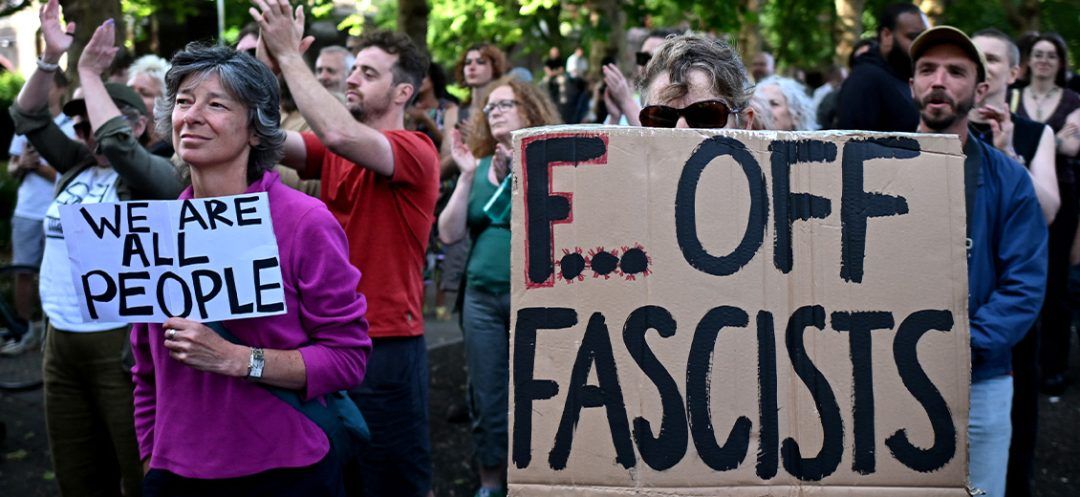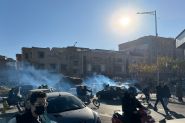- Home
- Middle East
- Southport: What Do Racist Riots Reveal About British Far Right Reality?

© Counter-protesters gather in Bristol, southern England, on August 3, 2024, against the 'Enough is Enough' demonstration held in reaction to the fatal stabbings in Southport on July 29. (JUSTIN TALLIS/AFP)
Everything seemed to indicate that the Southport tragedy would remain a significant topic in public debate, particularly regarding illegal immigration. However, the far-right's cynical exploitation of a single crime, portraying it as a racially and Islamist-motivated act, changed everything. This disgraceful manipulation triggered weeks of Islamophobic, racial and occasionally neo-Nazi riots, plunging the country into an unprecedented sociopolitical crisis.
On July 29, a knife attack in Southport, Northwest England, tragically took the lives of three young girls attending a dance class dedicated to American star Taylor Swift. After the crime was reported by the press, a wave of misinformation spread across social media, orchestrated by far-right groups and individuals. Among these false claims was a fabrication by misogynistic influencer Andrew Tate, which was viewed over 15 million times on X. Tate falsely alleged that the attacker was an illegal migrant, while in reality, the 17-year-old assailant was born in Cardiff, Wales, to Rwandan parents and had lived for years in a village near Southport. Described by the British press as introverted and homebound, he did not match the misleading narrative spread online.
Additionally, another false rumor, propagated by the xenophobic account "Europe Invasion" and viewed 7 million times, claimed that the suspect was Muslim. A fabricated name, Ali al-Shakati, was also used to fuel this false narrative. These fabrications quickly inflamed tensions, leading far-right activists, mainly from the English Defense League, to call for protests outside the Southport mosque. In response to the escalating situation, the British police, in a rare move involving a minor, had to disclose the suspect’s identity: Axel Rudakubana. Contrary to the rumors, he is not Muslim but an active altar boy at a local church.
So what about the reality of modern far-right influence in the United Kingdom? The murders in Southport of Elsie Dot Stancombe, Alice da Silva Aguiar and Bebe King were undoubtedly exploited by extremists who seized the tragedy to push their own hatred and agenda. Online lies and misinformation fueled the situation, with some key instigators using social media and messaging apps to spread hate and call for protests. This led to a series of violent gatherings over several days, where racial and religious hatred was the driving force. Crowds attacked hotels housing migrants, attempted to set buildings on fire, and dragged people from their cars.
The riots have been described as far-right by public figures, from the prime minister to local officials. For many, this suggests that the disturbances were orchestrated by formal and identifiable groups or political parties, and the history of far-right violence and protests, including through organizations like the British National Front, supports this view. However, the recent unrest is much more complex and reveals the chaotic nature of modern right-wing extremism and the extent of its influence.
This lack of cohesion makes the situation more unpredictable and dangerous. For authorities, the number of potential rioters and targets is significant, with no obvious groups to dismantle. In contrast, the counter-protests organized by anti-racist activists have been much more coherent and organized. Right-wing extremism itself can be viewed as a spectrum rather than a unified force. It includes neo-Nazis advocating for genocide, who are considered terrorists by the state. They hide behind online pseudonyms, reject activist campaigns, aim to destroy society and revere Adolf Hitler. But the spectrum also encompasses individuals who run in democratic elections, engage in public campaigns and present political platforms.
In many ways, right-wing extremism in the UK has transformed from a structure dominated by organizations and parties into a more diffuse network of loosely connected groups that primarily operate online. Neo-fascist political parties, such as the British National Party (BNP), which once had some electoral success, no longer play a major role. Today, traditional political leaders have become rare. Anti-Islam activist Tommy Robinson, whose real name is Stephen Yaxley-Lennon, is probably the most prominent figure in this realm, but he does not lead a unified movement. Instead, he represents a cult of personality, with his online rants and legal issues fueling a continuous media spectacle.
Parties like the BNP and the National Front still exist but have significantly diminished in influence and appeal, largely consisting of older members and failing to connect with younger generations. New, more extreme organizations have emerged, driven by young activists in the UK. However, notable groups such as National Action and Sonnenkrieg Division have been banned as terrorist organizations and dismantled through the efforts of anti-fascists, journalists and law enforcement. In response, some right-wing extremists have moved away from forming formal organizations, which attract police attention, and have instead created more informal networks, particularly online, where extremist channels and influencers can be followed. For example, some have joined small collectives like Patriotic Alternative (PA) or underground fighting clubs, where white men train in violence. These groups use less overtly extreme rhetoric than the banned organizations but still attract individuals with similar ideologies, with some PA members having been convicted of terrorism and hate crimes.
When violence erupts, it doesn’t always come from extreme neo-Nazis or individuals with a well-established history of extremism. The majority of people involved in the recent riots had no proven connections to the far-right or radical right. The participants came from diverse backgrounds, ranging from people over sixty to young teenagers, and were motivated by various reasons. Some were opportunistic criminals taking advantage of the chaos to loot and steal, while others were simply drunk and got swept up once the unrest began. However, among the rioters, some did have connections to the far right. For example, John Honey had participated in events organized by PA and was imprisoned for his role in what Judge John Thackray described as "twelve hours of racist and hateful violence" in Hull. Matthew Hankinson, present at the Southport riots, had just been released from prison after being convicted of belonging to the banned terrorist organization National Action.
In conclusion, the riots have once again demonstrated that exposure to far-right ideas and conspiracy theories doesn’t require being a neo-Nazi or a member of a racist fringe group – just being online is enough. Through this disinformation campaign, the far right appears to have a clear aim: to divide society and create a sense of racial conflict to draw more people to its radical ideologies. Prime Minister Sir Keir Starmer now faces his first major challenge, or even his first significant political crisis, with the Southport tragedy and the ensuing riots. This crisis, marked by increasing radicalization and polarization among the British public, is likely to persist and provoke intense debates for years to come. The situation highlights not only the growing sociopolitical tensions but also the government’s struggle to address deepening divisions. Extremism, fueled by widespread disinformation and hateful narratives, has exacerbated the climate of mistrust and conflict. How Starmer handles this issue in the coming months and years will be crucial in determining his ability to stabilize a country increasingly fractured and to restore some level of social cohesion. A key takeaway from this summer’s violence is that far-right narratives are now more embedded in the mainstream than many would like to admit.
Are we facing a more widespread far-right culture in society that goes beyond the need for organized political groups? If so, activists may feel encouraged by recent events, which could increase the risk of future violence...
Read more




Comments